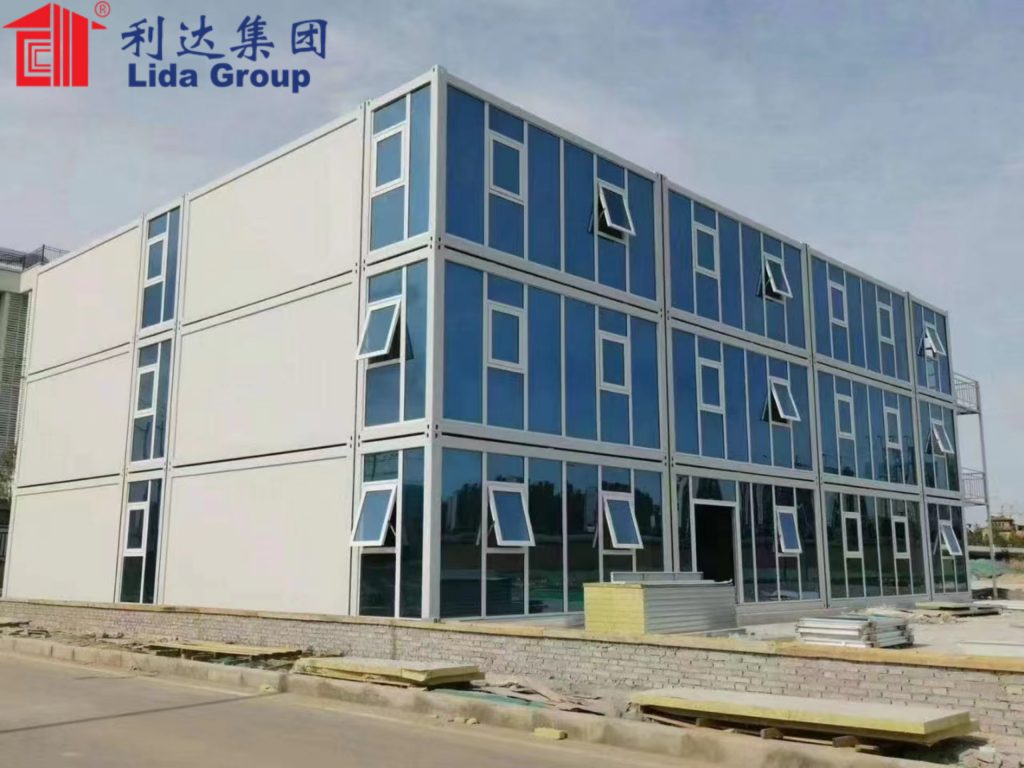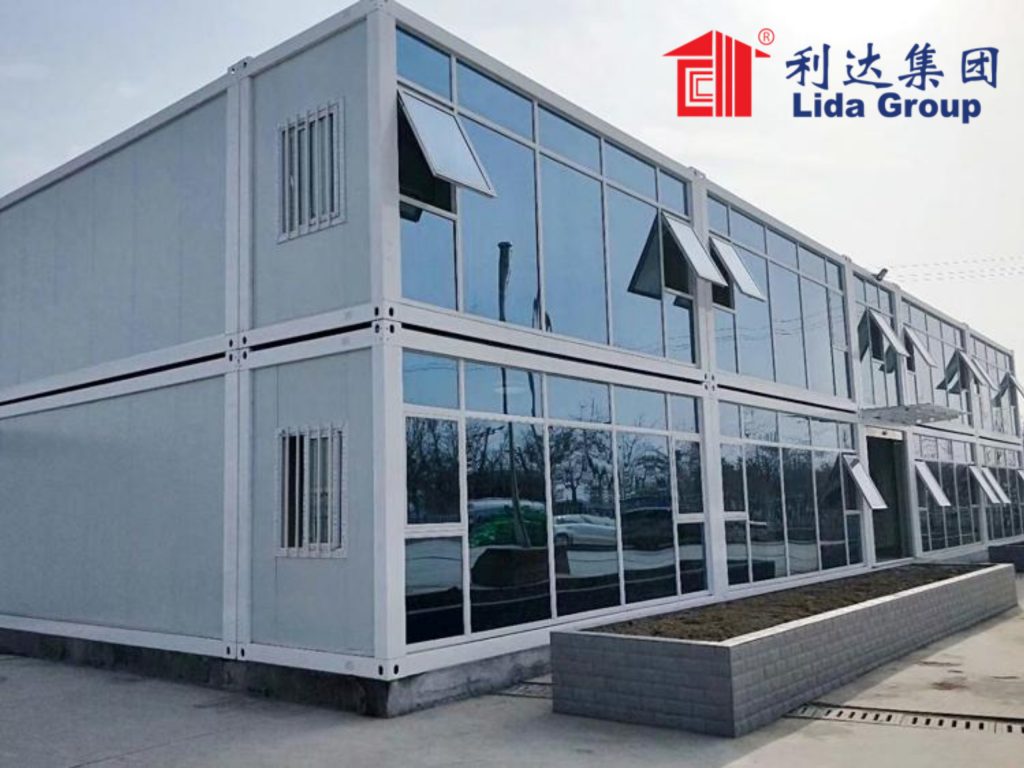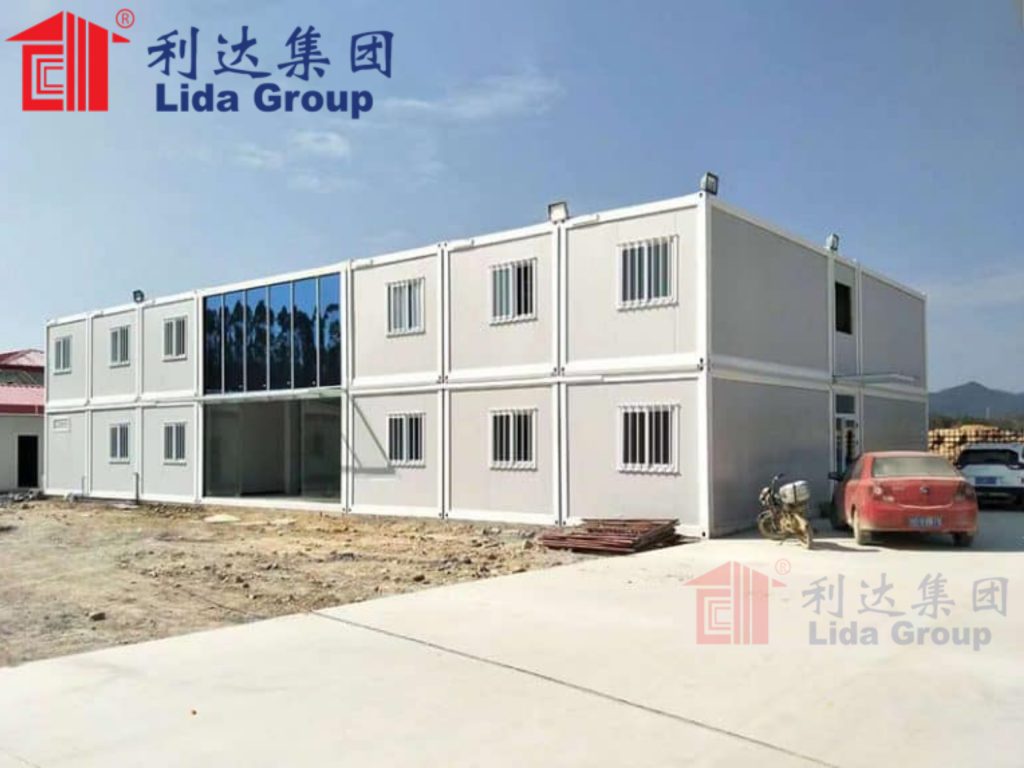Place of Origin: Shandong, China (Mainland)
Brand Name: Lida
Material: Sandwich Panel, Steel Structure
Use: Container House
Certificate: CE (EN1090), SGS ,BV, ISO9001, ISO14001, ISO45001
Delivery time: 15 to 30 days
Payment Terms: T/T, LC
Place of Origin: Shandong, China (Mainland)
Brand Name: Lida
Material: Sandwich Panel, Steel Structure
Use: Container House
Certificate: CE (EN1090), SGS ,BV, ISO9001, ISO14001, ISO45001
Delivery time: 15 to 30 days
Payment Terms: T/T, LC
In recent years, there has been a significant rise in the use of container buildings in temporary construction projects. The concept of utilizing shipping containers as a building material has gained traction due to its numerous advantages and modular nature. This introduction aims to shed light on the growing trend of container building in temporary construction and explore the reasons behind its popularity.
Container buildings, also known as shipping container construction, involve repurposing steel shipping containers into functional structures for various purposes. These structures can range from offices, classrooms, medical facilities, retail spaces, and even residential units. The versatility of container buildings makes them an attractive option for temporary construction needs.
One of the primary reasons behind the surge in container building is its cost-effectiveness. Compared to traditional construction methods, utilizing shipping containers can significantly reduce expenses on materials and labor. Additionally, their modular nature allows for faster assembly and disassembly, making them ideal for temporary projects where speed is crucial.
Furthermore, container buildings offer inherent sustainability benefits. By repurposing existing shipping containers that would otherwise go unused or end up as waste, this form of construction promotes recycling and reduces environmental impact. Container buildings also have a smaller carbon footprint compared to traditional construction methods.
In this section, we will delve deeper into the various use cases of container buildings in temporary construction projects and explore how they provide innovative solutions for modern-day challenges. Whether it’s addressing space constraints or providing quick solutions during emergencies or events, container buildings have proven to be a viable option that combines efficiency with sustainability in temporary construction endeavors.

When it comes to temporary construction projects, using containers can offer a range of benefits that make them an ideal choice. Not only are they cost-effective, but they also provide quick setup and dismantling options, making them a practical solution for time-sensitive projects.
One of the key advantages of using containers for temporary construction is their cost-effectiveness. Compared to traditional building materials, containers are readily available and can be repurposed for construction purposes at a fraction of the cost. This makes them an attractive option for businesses looking to minimize expenses without compromising on quality.
Additionally, containers offer quick setup and dismantling capabilities. With their modular design, these structures can be easily transported and assembled on-site in a matter of days or even hours. This not only saves valuable time but also allows for efficient project management and faster completion.
Furthermore, using containers for temporary construction is an eco-friendly choice. Many containers are made from recycled materials, reducing the demand for new resources and minimizing environmental impact. Additionally, their versatile design options allow for creative adaptations that incorporate sustainable features such as solar panels or rainwater harvesting systems.
In conclusion, the benefits of using containers for temporary construction projects are undeniable. From being cost-effective to providing quick setup and dismantling options, as well as offering eco-friendly building materials and versatile design possibilities – these factors make containers an excellent choice for any project requiring flexibility and efficiency.
When it comes to construction, cost-effectiveness and affordability are key considerations for any project. In recent years, container building has emerged as a budget-friendly construction solution that offers reduced material and labor expenses.
Container buildings utilize repurposed shipping containers, which are readily available at a fraction of the cost of traditional building materials. This significantly reduces the upfront costs associated with construction projects. Additionally, the modular nature of container buildings allows for easy scalability and customization, making them an attractive option for those working within a tight budget.
By opting for container building solutions, developers can save on both material and labor expenses. The use of pre-fabricated containers eliminates the need for extensive on-site construction work and reduces labor costs accordingly. Furthermore, the streamlined construction process results in shorter project timelines, translating into additional savings.
In summary, container buildings offer a cost-effective and affordable alternative to traditional construction methods. With reduced material and labor expenses, they provide an attractive solution for those seeking budget-friendly construction options without compromising on quality or functionality.
When it comes to setting up and dismantling processes, speed and efficiency are crucial. In today’s fast-paced world, businesses and organizations need solutions that can be implemented quickly without causing major disruptions. This is where the concept of speedy setup and dismantling processes comes into play.
One of the key advantages of a quick installation time is that it allows businesses to save valuable time and resources. Instead of spending days or weeks on setting up equipment or structures, a speedy setup process ensures that operations can start promptly. This not only increases productivity but also enables businesses to meet tight deadlines and deliver results faster.
Moreover, easy transportation and logistics play a vital role in ensuring smooth setup and dismantling processes. By utilizing equipment or structures that are designed for easy transportation, businesses can avoid unnecessary delays or complications during the installation phase. This not only saves time but also reduces costs associated with complex logistics arrangements.
Furthermore, a speedy setup and dismantling process minimizes disruption to surrounding areas. Whether it’s a construction site in a busy urban area or an event venue in a crowded location, minimizing disruption is essential for maintaining good relationships with neighbors, customers, or stakeholders. By efficiently setting up and dismantling structures or equipment without causing significant disturbances, businesses can ensure smooth operations while preserving positive community relations.
In conclusion, the concept of speedy setup and dismantling processes offers numerous benefits for businesses across various industries. From saving time and resources to minimizing disruptions to surrounding areas, this approach enables organizations to operate efficiently while meeting their objectives effectively.
In the quest for a more sustainable future, the use of eco-friendly building materials has gained significant attention. One such approach is the utilization of recycled containers as a viable alternative to traditional construction materials. By repurposing existing resources, we can reduce our carbon footprint and contribute to a more environmentally conscious approach to building.
Recycled containers offer numerous benefits in terms of sustainability and efficiency. These containers, which would otherwise end up in landfills, can be transformed into structurally sound and aesthetically pleasing building components. This not only reduces waste but also minimizes the need for extracting and manufacturing new materials.
Moreover, incorporating recycled containers into construction projects significantly decreases energy consumption during the production process. In comparison to traditional building materials like concrete or steel, repurposing containers requires less energy and emits fewer greenhouse gases.
The versatility of recycled containers allows for innovative architectural designs while maintaining structural integrity. From residential homes to commercial spaces, these repurposed structures showcase creativity in sustainable construction practices.
In conclusion, embracing sustainable and eco-friendly building materials such as recycled containers offers a practical solution towards reducing our environmental impact. By repurposing existing resources for construction projects, we can contribute to a greener future while simultaneously creating unique and visually appealing structures.
In today’s dynamic world, the need for versatile design options is more important than ever. Whether it’s creating spaces for offices, schools, or clinics, having customizable container layouts and flexible space configurations can greatly enhance functionality and efficiency.
Customizable container layouts offer endless possibilities when it comes to designing spaces for various applications. With the ability to modify and adapt the layout according to specific requirements, businesses can create environments that cater to their unique needs. From open-plan offices that foster collaboration to segmented spaces in clinics for privacy and comfort, the possibilities are limitless.
Flexible space configurations further add value by allowing seamless transitions between different purposes. For example, a school may require classrooms during the day but could transform those same spaces into a multipurpose area for events or workshops after hours. With adaptable designs, businesses and institutions can optimize their use of space without compromising on functionality.
By embracing these versatile design options, businesses can create environments that not only meet their immediate needs but also have the flexibility to adapt as those needs evolve over time. Whether it’s maximizing productivity in an office setting or creating an inviting atmosphere in a clinic or school, customizable container layouts and flexible space configurations offer practical solutions for various applications.
Container buildings have revolutionized the concept of temporary construction, offering versatile and cost-effective solutions for various purposes. In this section, we will explore inspiring examples of successful container building projects that have made a significant impact in different sectors.
One remarkable use case of container buildings is in disaster-stricken areas, where traditional infrastructure may be lacking or destroyed. Container classrooms have been deployed to ensure that education continues amidst chaos. These portable learning spaces provide a safe and conducive environment for students to continue their studies, even in the most challenging circumstances.
Another exciting application of container buildings is seen in the realm of retail. Pop-up stores have gained popularity as a trendy and flexible way for businesses to showcase their products or test new markets. Utilizing containers allows these retail spaces to be easily transported and set up in various locations, providing brands with an opportunity to engage with customers on a temporary basis while maintaining a unique and eye-catching aesthetic.
Furthermore, container buildings have also played a crucial role in emergency medical facilities. In times of crisis or during large-scale events, such as natural disasters or pandemics, these structures can quickly be converted into fully functional medical units. Equipped with essential equipment and supplies, container-based medical facilities offer efficient solutions for triage centers or additional treatment spaces when traditional healthcare infrastructures are overwhelmed.
These inspiring examples demonstrate the versatility and effectiveness of container buildings in temporary construction projects. From providing education in disaster-stricken areas to facilitating innovative retail experiences and supporting emergency medical services – containers have proven their worth as reliable solutions that can be rapidly deployed when needed most.

The future of temporary construction is being shaped by the growing popularity of container buildings. With evolving trends in container architecture, innovations in sustainable materials, and advancements in modular technology, these structures are set to revolutionize the industry.
Container buildings offer a unique blend of versatility, affordability, and sustainability. The use of repurposed shipping containers as building blocks not only reduces waste but also provides a cost-effective solution for temporary construction projects. As more architects and designers explore the creative possibilities offered by container architecture, we can expect to see exciting new trends emerge.
One key trend is the integration of sustainable materials into container buildings. Innovations in eco-friendly materials such as recycled plastics, bamboo composites, and energy-efficient insulation are making these structures more environmentally friendly than ever before. This focus on sustainability aligns with the growing global consciousness towards green construction practices.
Advancements in modular technology further enhance the potential of container buildings. Modular construction allows for efficient off-site fabrication and quick on-site assembly, reducing construction time and costs significantly. Additionally, modular designs offer flexibility for expansion or relocation as project needs evolve.
The future outlook for container buildings in the field of temporary construction is promising. As trends continue to evolve and innovative solutions emerge, these structures will play an increasingly significant role in meeting the demands of fast-paced industries such as events, pop-up retail spaces, disaster relief efforts, and even affordable housing initiatives.
In conclusion, with ongoing advancements in sustainable materials and modular technology alongside emerging trends in container architecture, we can confidently say that container buildings have a bright future ahead within the realm of temporary construction.

In conclusion, embracing the versatility and efficiency of container buildings for your next temporary construction project is a smart choice. These innovative structures offer numerous benefits that traditional construction methods cannot match.
Container buildings are highly versatile, allowing for customization and adaptability to suit various project needs. Whether you require office spaces, storage facilities, or temporary housing solutions, container buildings can be easily modified and repurposed to meet your specific requirements.
Moreover, container buildings are incredibly efficient. They can be constructed quickly and cost-effectively compared to traditional construction methods. Their modular nature allows for easy transportation and assembly on-site, saving both time and money.
By opting for container buildings, you not only benefit from their practicality but also contribute to sustainable practices. Repurposing shipping containers reduces waste and promotes recycling in the construction industry.
So why limit yourself to conventional construction when you can embrace the versatility and efficiency of container buildings? Consider these innovative structures for your next temporary construction project and experience the many advantages they have to offer.

Our team will use our experience to provide the professional services .
